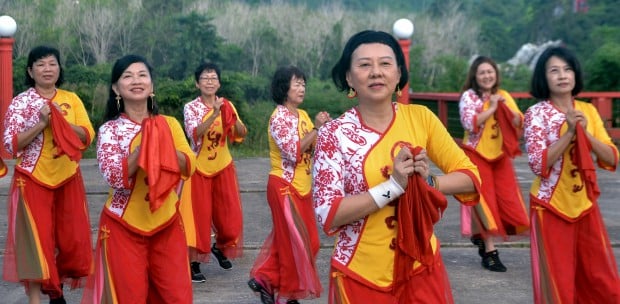KUALA LUMPUR: In the rich tapestry of Southeast Asia's cultural heritage, few symbols express Malay tradition, elegance and identity as profoundly as the songkok.
This headgear, revered for its historical significance and timeless style, remains a cherished accessory across Malay communities and serves not only as a fashion statement, but also as a symbol of religious devotion and cultural pride.
Considered one of the last few songkok makers in the country, brothers Risnaldy and Firdaus Bachtiar are determined to continue their late father's legacy.
For over 40 years, their father, Bachtiar Mustafa, weaved magic with his skilled hands, transforming pieces of velvet and hardened paper into exquisite headwear worn by men far and wide in his aptly named "Kedai Songkok", located in Keramat Mall at Kampung Datuk Keramat, here.
Bachtiar's passing last February threw Risnaldy and Firdaus into the deep end when they had to perfect their father's craftsmanship in time for this year's Hari Raya demand.
Risnaldy, however, said his father's death gave him the motivation to preserve the legacy.
"It was my late parents' wish that the business be continued.
"If not me, who else will continue his legacy?"
STEEP LEARNING CURVE
Risnaldy said he had only been learning to make songkok properly in the last three to four years and had only made a couple under his late father's guidance.
His day job is driving a taxi.
"So (making the songkok) is off and on for me. The skill is not consistent."
Risnaldy added that the most challenging part of making the headwear was attaching the top of the songkok with its sides.
"The challenge is to sew the edges together to assemble the songkok.
"It requires a degree of skill to thread the needle into the material perfectly."
Risnaldy aims to match his late father's pace of one songkok every four hours, noting that he currently needs a day or two to complete one.
His brother, Firdaus, is also trying to learn the ropes of songkok making since his late father did not teach him the tricks of the trade as he is left-handed.
He said the challenge was ensuring the exclusive shape of the songkok, adding that it took years to perfect.
"I've always wanted to learn how to make one, I even asked my late father to teach me.
"However, it is difficult for me to operate the sewing machine due to my left-handedness."
Firdaus now takes a more modest role in manning the shop, setting it up in the morning and tending to customers before his older brother comes in to work later in the day.
QUALITY LIKE NO OTHER
The songkok made by the late Bachtiar and now his sons has its cult following as customers enjoy the handmade quality paired with very affordable prices.
Firdaus said the headwear was typically sold between RM60 and RM70 depending on the type of velvet used.
"The quality of this songkok is not the same as that of others on the market, as it is made with thicker material. This means its structure is more durable and long-lasting.
"We also use higher-quality velvet."
Firdaus said they also took custom orders according to the customer's head size, ensuring a perfect fit for its wearer.
This, he added, had led to a loyal customer base which spanned the length and breadth of the country, with a customer from as far away as Johor coming to seek songkok made by the late Bachtiar.
"One customer had been coming every year to the shop ever since he was 10.
"Back then, my father was selling the headwear at the night market nearby.
"The customer is now 40 years old, and he told us that the songkok we make is very comfortable and unrivalled on the market," Firdaus said.
Sharing one of the unique requests that the shop had received throughout the years, Risnaldy said it was for a one-of-a-kind Songkok Tinggi measuring a whopping 12-inches tall.
"The request came in last year, with the customer wanting a tall songkok for a performance.

"My father obliged, attempting the impossible."
Risnaldy added that the songkok presented a challenge as it required sewing an unreachable section by the sewing machine.
"To this day I am still trying to figure out how my father managed to complete it," he said.
The twist in the end was that the order went uncollected.
However, it stood as a monument to the capabilities of the songkok makers of "Kedai Songkok".
DEMAND DECLINING
From what was then 400-500 songkok sold from the start of Ramadan till the Aidilfitri holidays, Risnaldy said the numbers had now been reduced by half.
He explained that this decline was partly due to the frugal spending of customers in the current economy, as well as lack of interest in the cultural and historical significance of the headwear.
"Demand for the songkok only comes as Hari Raya approaches.
"Our shop also makes songkok for other businesses which are selling them, and this year, we see the demand dropping."
Risnaldy, however, remains optimistic, as he believes the headwear is evergreen in the heart of Malay culture.
"I feel that as time evolves, the songkok will stay relevant. However, the younger generation has no interest in continuing the tradition," he lamented.
He added that the business of songkok making was not for those seeking profit, but the art of crafting the songkok made it invaluable.
Firdaus also echoed his brother's sentiment and said more needed to be done so wearing the songkok could be the norm.
"It needs more promotion. We should put it on not just for religious and formal occasions, but also as daily wear.
"I would love to see people wearing it anywhere and everywhere, just like in the olden days."





